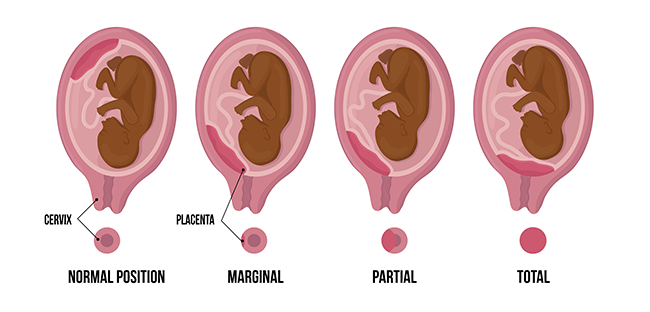Placenta Accreta Spectrum (PAS)

Experts from across OHSU come together to plan for and deliver your baby if you are diagnosed with placenta accreta spectrum. In this serious condition, the placenta grows into the wall of the uterus and does not separate after your baby’s birth.
We offer:
- A birth plan developed by experts and tailored to your condition.
- Delivery in a setting with advanced surgical techniques and support at the ready.
- Immediate access to services you might need during delivery.
- Close monitoring as your delivery date nears to make sure you and your baby have the best possible outcome.
What is placenta accreta spectrum?
Placenta accreta spectrum, or PAS, includes three conditions in which the placenta grows too deeply into the wall of the uterus. PAS is usually seen during a routine prenatal ultrasound. It is monitored with more imaging, such as more ultrasounds or an MRI.
People with PAS often have no symptoms during pregnancy. Some people have vaginal bleeding late in pregnancy. PAS can be life-threatening at delivery because it can lead to massive blood loss.
The three PAS conditions are:
Placenta accreta: The placenta grows into the uterine lining and does not separate easily at delivery.
Placenta increta: The placenta grows into the muscle of the uterine wall.
Placenta percreta: The placenta grows through the uterine wall and may grow into other organs.
Many people who have a PAS condition also have a placenta previa.
Placenta previa: This is when the placenta covers the cervix — the opening between the uterus and vagina. It can cause bleeding throughout pregnancy. If your placenta still covers your cervix when it’s time to deliver, you may need a C-section.

Who is at risk for placenta accreta spectrum?
PAS is rare, but the rate has been rising for decades along with C-section rates. It now occurs in about 1 in every 272 births, up from 1 in every 1,250 births in the 1980s.
Risk factors include:
- A prior C-section, especially more than one
- Placenta previa in this or a previous pregnancy
- Prior procedures on the uterus, such as removal of fibroids or polyps, or a procedure after a miscarriage
- Asherman’s syndrome (scars inside your uterus)
At OHSU, our imaging specialists screen all pregnant patients for PAS during prenatal ultrasounds. If you’re at risk, we offer extra monitoring throughout your pregnancy.
Treatment for placenta accreta spectrum
In almost every case, we recommend an early delivery via C-section and a hysterectomy (removal of your uterus). In rare cases, we can safely avoid a hysterectomy. However, without a hysterectomy you may have complications after delivery and in future pregnancies.
Our team of experts will review your case and create a care plan tailored to you. Often, you can continue prenatal care with your chosen provider. We may recommend additional imaging and monitoring. We will also help choose the best time for delivery. As your delivery date nears, we may monitor you more often.
Because PAS makes childbirth dangerous, we usually recommend your delivery be:
- Planned in advance based on your condition and its severity, and your health history. We also plan in advance to make sure all members of your care team members are available for you and your baby.
- Early, usually between 34 and 36 weeks of pregnancy. Going into labor could lead to bleeding and an emergency delivery. A planned early delivery reduces these risks.
- By C-section to control bleeding and keep you and your baby safe during delivery.
- With our team at OHSU Hospital where you have access to the expertise and resources needed to make your delivery as safe as possible. These include a large blood bank, anesthesiologists, specialists in complex pelvic surgery and a Neonatal Intensive Care Unit (NICU).
- Followed by a hysterectomy. When we deliver your baby, we will evaluate your uterus and placenta and talk with you about your options. Most people with PAS do need a hysterectomy.
PAS itself does not harm your baby, but your baby will be at risk for complications from prematurity. We recommend you deliver with our team so we can reduce these risks. For example, steroid shots may prepare your baby for early birth by helping their lungs develop faster.
Your baby may spend a few weeks in the OHSU Doernbecher Children’s Hospital NICU.

Our excellence
A team approach: Many specialists from across OHSU work together to review your ultrasound images and to create the best plan for your delivery. This team will work with you and your prenatal care provider to monitor you during the rest of your pregnancy.
Immediate access to trauma care: If any problem arises during delivery, we have experts and resources at the ready:
- High-risk pregnancy experts (perinatologists)
- Trauma surgery
- Experts in complex pelvic surgery
- Urology
- Interventional radiology
- Blood bank
- NICU
Housing before delivery: If you live far from Portland, we may be able to offer local housing towards the end of your pregnancy. It’s essential that we monitor you closely as your delivery date approaches.
Stay awake for your baby’s birth: Our anesthesia team’s advanced options allow almost all of our patients to stay awake and have their partner with them for their baby’s birth.
What to expect
At your first appointment with us, we start with a detailed ultrasound. Our team members work together to get all the images we need to understand exactly where your placenta is and how it is growing. You can expect:
An individual birth plan: Our expert team will tailor a plan to you and your condition.
Careful monitoring: As your pregnancy progresses, we will monitor you more closely to check for any changes, or problems such as vaginal bleeding. We will make sure you know what to do if you have bleeding or signs of labor.
Meet your delivery team: When you arrive at the hospital the day before delivery, we will introduce you to your care team. This includes your surgeon, anesthesiologist, and the neonatology team that will care for your baby.
Learn more
What do accreta patients need to know? National Accreta Foundation
For patients
Call 503-418-4200 to make an appointment.
Location
Parking is free for patients and their visitors.
Physician’s Pavilion
3270 S.W. Pavilion Loop
Portland, OR 97239
Map and directions
Hillsboro Medical Center
8th Avenue Medical Plaza
364 S.E. 8th Ave., Suite 201
Hillsboro, OR 97213
For referring providers
We partner with you to care for patients with high-risk pregnancies.
- Refer your patient to OHSU.
- Call 503-494-4567 to seek provider-to-provider advice.